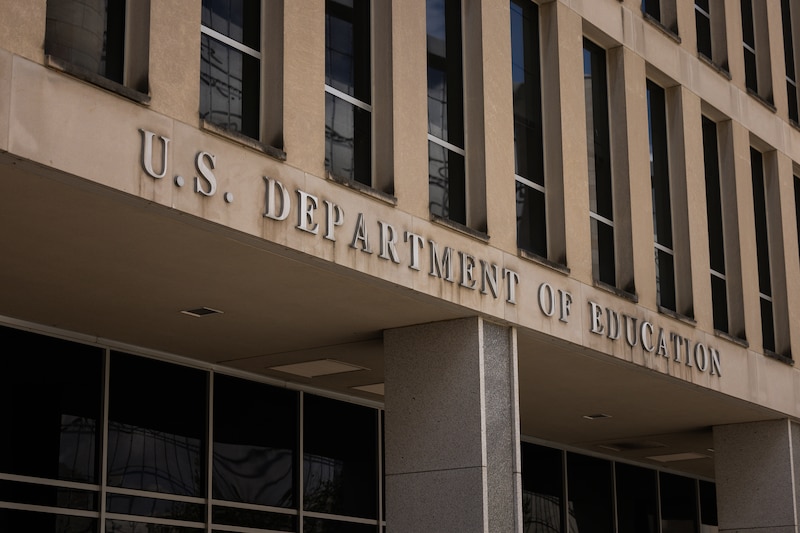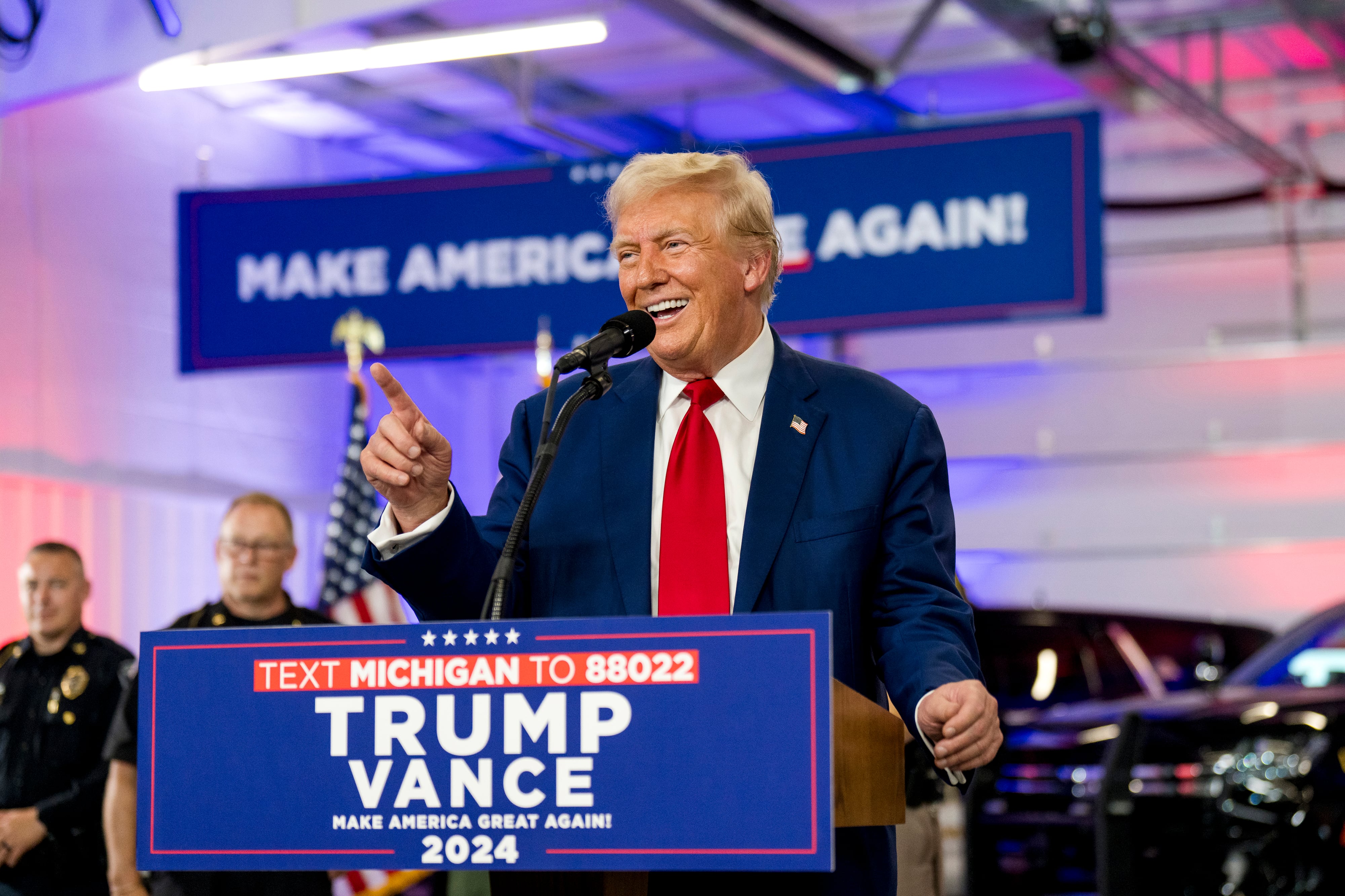Sign up for Chalkbeat’s free weekly newsletter to keep up with how education is changing across the U.S.
When Donald Trump told Elon Musk one of his first acts as president would be to “close the Department of Education, move education back to the states,” he was invoking a GOP promise that goes back to President Ronald Reagan and the department’s founding.
Yet through multiple Republican administrations, including Trump’s first term, the U.S. Department of Education has persisted.
That hasn’t stopped Democrats from sounding the alarm that Trump’s views epitomize the GOP’s bad intentions for public schools. The fact that the Republican Party’s platform also calls for closing the department, as does the conservative Heritage Foundation’s Project 2025, has only intensified Democrats’ distress.
“We are not going to let him eliminate the Department of Education that funds our public schools,” Vice President Kamala Harris said to thunderous applause in her speech at the Democratic National Convention, where she placed the department alongside prized institutions and programs like Social Security, Medicare, and the Affordable Care Act.
The department has become a “kind of trophy” in a larger debate about the meaning of public education, said Rick Hess, director of education policy studies at the American Enterprise Institute.
In fact, he said, “The Department of Education actually has very little to do with that debate. Abolishing it doesn’t advance school choice and keeping it doesn’t do much for traditional district schools. But it’s become a symbol of which side you’re on in that debate.”
So, what exactly does the U.S. Department of Education do? Why do so many conservatives want to see it go away? Why has it survived? And what would it take for that to actually happen?

The U.S. Department of Education: a brief history
The federal government spent money on education and developed education policies going back to the 19th century. But the U.S. Department of Education didn’t become a stand-alone agency until 1980, when it split off from the U.S. Department of Health, Education, and Welfare.
President Jimmy Carter advocated for the creation of the department to fulfill a campaign promise to the National Education Association. Congress passed the Department of Education Organization Act in 1979. Some Democrats and the American Federation of Teachers opposed the idea, due to fears about excessive federal meddling in local education decisions and concerns that it would cater to the NEA’s interests.
Reagan, Carter’s successor, campaigned on abolishing the brand-new department. But Reagan’s first education secretary, Terrel Bell, commissioned the landmark report “A Nation at Risk: The Imperative for Educational Reform,” warning that America was losing its competitive edge. It advocated for a strong federal role to ensure students received a high-quality education.
“If the federal government is coming out with a report that shows all the things that need to be fixed and at the same time, we’re backing out of it, those are not compatible positions,” said Michael Feuer, dean of George Washington University’s Graduate School of Education and Human Development.
The U.S. Department of Education does a lot of things, like monitor school performance and promote evidence-based practices. Its biggest K-12 programs by dollar amount provide money to high-poverty schools and for students with disabilities. Some of its most high-profile and controversial work involves enforcing civil rights protections. The department also plays a major role in distributing financial aid for higher education.
The department is not the primary funder of U.S. schools. Before the infusion of pandemic relief dollars, the federal government only covered about 8% of K-12 educational costs. In recent years, it’s been closer to 11%. But refusing that money to avoid federal rules isn’t necessarily easy.
Why do conservatives want to end the Department of Education?
Some of the dislike is purely ideological.
For conservatives, less government is better. Education is not mentioned directly in the U.S. Constitution. And a new department overseeing functions that remain mostly the purview of local government is low-hanging fruit.
Under Democratic administrations, the department has also sided with more progressive approaches to education and to civil rights enforcement.
The Obama administration, for example, told schools that if they suspended or expelled Black students at much higher rates than other groups, that could be a sign they were illegally discriminating in how they administered student discipline. Critics said the rules pushed schools to adopt laxer disciplinary policies that made schools less safe. Betsy DeVos, Trump’s education secretary, rescinded those rules. (The Biden administration has not reinstated them.)
More recently, the Biden administration issued Title IX rules that provide greater and more explicit protections for LGBTQ students — rules that Republican-led states have sued to block.
Jonathan Butcher, a senior fellow at the Heritage Foundation, said states have been a source of innovation, like charter schools and educational savings accounts. The federal department not only distracts states from efforts to improve education but creates unnecessary bureaucracy.
All the while, achievement gaps based on race and poverty haven’t gone away, Butcher noted, though they have narrowed by some measures.
“We have ample evidence that it is not serving its purpose,” Butcher said of the department. Abolishing it, he added, is “consistent with both the interest in smaller government and the interest in doing what’s right for kids.”
What does Trump say about abolishing the Department of Education?
In his conversation with Musk that aired on X, the social media platform previously known as Twitter, Trump said the U.S. had a “horrible” education ranking at the bottom of developed countries while spending the most.
It’s not totally clear what sources Trump was using. On recent international tests, the U.S. ranked sixth in reading, 10th in science, and 26th in math among 81 countries. Older test results show the U.S. ranked lower, especially in math. The U.S. does spend more per-pupil than most developed nations, including many that score better on key measures.
Trump said some states won’t do well, but many would do a better job on their own while spending less money.
“Of the 50, I would bet that 35 would do great, and 15 of them or 20 of them would be as good as Norway,” Trump told Musk. “You know Norway is considered great.”
He said the federal government could provide “a little monitor. You want to make sure they are teaching English, as an example. Give us a little English, right?”
Trump’s campaign did not respond to a request to elaborate on the candidate’s plans.
How would abolishing the Department of Education work?
Abolishing a federal department would require an act of Congress, just as creating one does. It likely would also require broad bipartisan support, which the idea doesn’t have.
U.S. Rep. Thomas Massie, a Kentucky Republican, has regularly introduced legislation to abolish the department — but the bill has failed to gain traction.
Despite that, Massie said his proposals were serious. “Damn right I want to terminate the Department of Education,” he said in a statement. “Public education in America has gone downhill ever since this bureaucracy was created.”
The Heritage Foundation’s Project 2025, widely seen as a blueprint for a future Trump administration — despite the candidate’s denials — lays out a much more detailed plan that considers necessary steps from Congress and the executive branch.
For example, the plan says civil rights enforcement should move to the Department of Justice, educational data collection to the U.S. Census Bureau, and support for Native American students to the Bureau of Indian Affairs.
Butcher acknowledged that BIA schools don’t have a good track record. But he argued that the agency was better positioned to work on improving educational outcomes.
Meanwhile, Project 2025 says Title I funding for high-poverty schools should be turned into vouchers and then phased out over time, while money from the Individuals with Disabilities Education Act should be given directly to parents.
On a podcast earlier this year, Lindsey Burke, the Heritage Foundation’s director of the Center for Education Policy and author of Project 2025’s education chapter, acknowledged the political difficulty of simply abolishing the department.
But she said the executive branch could take certain actions on its own, such as ending student loan forgiveness programs and not enforcing the new Title IX rules.
Ending the Education Department now ‘part of the conversation’
Hess, of the American Enterprise Institute, said he doesn’t oppose eliminating the department, but the idea has become a kind of “boogie man or quick fix” that’s become a substitute for substantive debate on the federal role in education.
“So much of the culture war that reached a boil during the pandemic focused on schools and colleges, which made the department more contested terrain and made education more contested terrain,” he said.
He’s skeptical that a future Trump administration would get any closer to eliminating the department than the first one did. And a recent U.S. Supreme Court decision limiting the power of administrative agencies could make it even harder to make dramatic changes via executive order, Hess said.
Feuer, of George Washington University, thinks the department has made positive contributions, despite some flaws, and wants to see it stick around. An unfriendly administration could dramatically cut funding or eliminate programs without eliminating the department. That’s the wrong debate to have when students are still recovering from COVID disruptions, he said.
“If we now take this really important moment and get everyone fighting about maintaining the department, instead of keeping our eyes on the kids and the teachers and doing some good work, that would be a really unfortunate distraction,” he said.
Butcher acknowledged that it’s “a big, ambitious idea,” but said it’s also a serious one. Past efforts, he said, lacked willpower and an advocate who prioritized it.
He was encouraged when every candidate in Republican presidential primary debates last year (except Trump, who did not participate) said they supported ending the department.
“We have made it a part of the conversation,” Butcher said.
Erica Meltzer is Chalkbeat’s national editor based in Colorado. Contact Erica at emeltzer@chalkbeat.org.
If you are having trouble viewing this form, go here.






